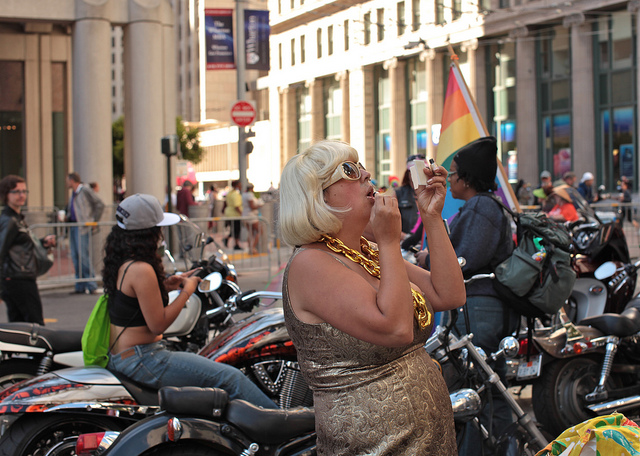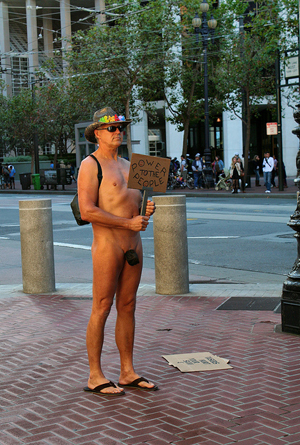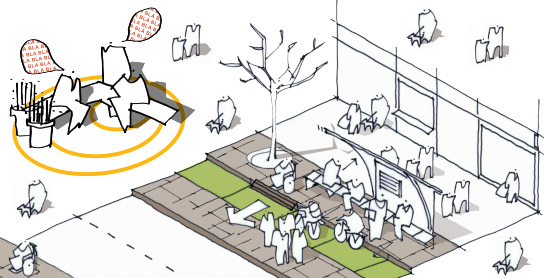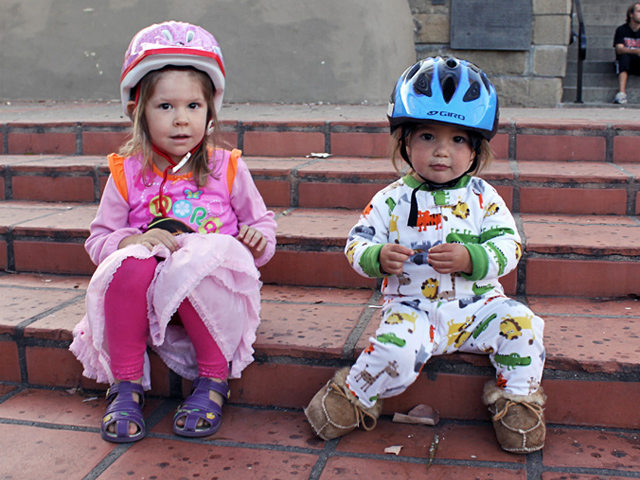In 1906, before the big quake, Market Street was one of America’s most important commercial streets. According to Rick Laubscher, president of the non-profit preservation group Market Street Railway, who narrated this fascinating short film taken on Market Street just days before the big quake, Market Street was a pretty big deal back then. “People dressed up to visit it,” he says, “and everyone wore a hat. You’ll see hundreds of people in this film but not a single bare head.”
[youtube]http://www.youtube.com/watch?v=NpFvp_nWBkc[/youtube]
Today, plenty of San Franciscans still do dress up to visit Market Street, much like their predecessors did a century ago.

Photo by torbakhopper
However, lots of today’s San Franciscans will also spend hours selecting just the right outfit for a root canal or a bikini wax appointment. The majority of people, though, arrive on today’s Market Street undeniably underdressed, a few even wearing flip flops, lending the area a distinctly come-as-you-are vibe.

No bare heads here.
Photo by John Martinez Pavliga
And who can be surprised? With the exception of a couple of cool new bike shops, an attractive genius bar, the city’s densest cluster of BART and MUNI stops, a steady stream of beautiful historic streetcars, and one spectacularly long line for our internationally famous amusement park ride, on an average day, there just isn’t much to attract the runway crowd to Market Street east of Octavia.
Thankfully, the SFDPW, SFMTA, SFCTA, SFOEWD, and the SF Planning Department have teamed up to create the Better Market Street Project. The BMS project’s plan is to take advantage of the next scheduled repaving of Market Street to try to restore the corridor’s former glory as a destination not just for San Franciscans but for the entire Bay Area and beyond. They want Future Market Street to give visitors something to write home about and locals someplace to wear a hat to. They want to increase the daily population along the street while simultaneously easing circulation of all of the ways people transport themselves there.
These are ambitious goals, so I decided to attend one of their recent public workshops to see how they figure they’re going to make all of this happen.
![]() The presentation opened with hopelessness and despair as they announced that, while originally scheduled for 2015, implementation is now forecasted to start in 2016, finishing sometime in 2017, by which time I’ll be in my 40s and my life will be over anyway.
The presentation opened with hopelessness and despair as they announced that, while originally scheduled for 2015, implementation is now forecasted to start in 2016, finishing sometime in 2017, by which time I’ll be in my 40s and my life will be over anyway.
Nevertheless, I stayed on to see some of the sorts of things that might be going on along Market Street before I die, and it’s a good thing, too, because the black clouds were scattered and my mid-life crisis forestalled the moment I spotted all the prominent displays featuring headless people in onesies walking their dogs, waiting for buses, carrying shopping bags, sitting in wheelchairs, casting shadows, and saying bla bla bla to each other.

Headless chickens in their PJs, a reinterpretation of some public material available on the BMF website.
Why? Because not only does clothing the populace in pajamas give these Future Market Street vistas a distinctly cozy, living-room feel (or, alternatively, a Pajama Jammy Jam feel, something that is sure to appeal to the fashionistas of SF), but if you’ve seen these types of drawings before, you know this also means that someone in San Francisco knows about Gehl Architects and has invited one or two of them to the project. This warms my heart because, although they don’t know how to make a website go fast, when it comes to urban design, as I’ve mentioned before, these guys really know their chicken.

Future Market Street’s target audience
Photo by SLO County Bicycle Coalition
The Better Market Street project has three objectives, as stated in their fact sheet:
- To create a sense of place through sustainable designs that celebrate local culture and diversity, and elevate Market Street as the signature destination in the Bay Area
- To optimize sustainable mobility so that all users have a pleasant, reliable, efficient, and comfortable experience
- To foster economic development for a productive, healthy, resilient and vibrant* corridor.
Easy peasy.
The first public outreach campaign in May 2011 was about clarifying the public’s priorities for the future of the street, which helped to frame the discussion for this, the second round of public workshops, each of which was divided into five different angles on the problem, five separate points of discussion for attendees:
- Public Space – This is for when people take up space, publicly
- Streetlife – This is for when living things accumulate along the street and occasionally play frogger with the traffic on the street in an attempt to get to their frog homes at Forever 21 or Blue Navy.
- Bicycle Facility – This is for when people on bikes try not to hit other street life while partaking in a delicate dance with buses, cabs, and vehicular tourists, all texting and flapping their doors while driving.
- Public Transit – This is for when people take the bus to the street in order to become a street life while they wait for another bus.
- Private Auto Circulation – This is for when tourists mistakenly think there’s parking on Market Street and then get trapped there, forced to be as menacing as possible to street life until they can find their way out.
I’ll address these five aspects of the discussion in a few upcoming posts, so shake well and buy often.
* Bill Lindeke of Streets.MN recently had some things to say about saying things about using the word vibrant, but I stopped reading when I saw the word boondoggle. Perhaps all of us would be wise to consider something a Boston University Linguistics professor once said to me: “If you repeat a word to yourself long enough, you die.”
Unless otherwise noted, all photos used in this post are licensed as part of the Creative Commons

Thanks for the link. Word over-use was something I mentioned my piece on vibrancy, funnily enough, only I used Gertrude Stein instead of a linguistics professor to illustrate my point. I’d argue that the word “boondoggle” is a good one, though, maybe over-used in this particular parlance, but rare enough elsewhere.
Oh my objections to boond*ggle are purely emotional and not at all related to its appropriateness or its actual overuse by any objective measure. For me it has just a hint of that listening-to-the-golfing-for-Jesus-audio-series vibe, which just makes it all the more applicable to a number of protracted and endlessly detoured city planning projects and studies, past and present (but usually both). In fact, at an SFMTA meeting I attended today, I was shocked that the word wasn’t used even once by a particular board member who was especially disenchanted with the fact the Geary BRT project appears to have made little-to-no progress in the last 8 years, and this after BRT was touted and promoted for being oh so much quicker, easier, and cheaper to implement than rail. If I weren’t handicapped by such an inexplicable and visceral reaction to the word, I’d perhaps have used it myself during the public comment period.
Bill,
Having just turned 60 in February I can assure you that life does NOT end anywhere close to one’s 40th birthday for most of us. The warranty may expire at 40 (like the old Michelin 40,000-mile tire warranty) but life also begins at 40, as the saying goes.
It may well take until your 60th birthday for the City and County of San Francisco to figure out how to revitalize Market Street, but you will probably still be around and not hopelessly “out of gas”–at least figuratively speaking–at that point.
Just keep breathing. You’ll grow up soon enough.
Jon